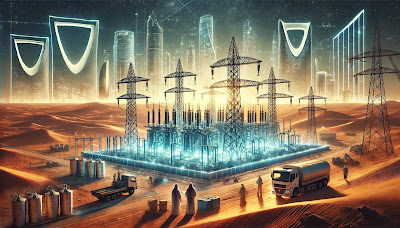Introduction
Larsen & Toubro (L&T), a global leader in engineering and construction, has secured new substation contracts in Saudi Arabia and the UAE, marking a major step in power distribution and grid modernization. These projects align with the region’s ambitious energy transition goals, focusing on renewable energy integration, high-voltage direct current (HVDC) transmission, and smart grids.
With the increasing electrification of transportation and the rising data center energy demand, grid resilience has become a top priority. L&T’s new substations will play a crucial role in enhancing the reliability, efficiency, and security of electricity distribution in the Middle East. The contracts also align with global trends in decarbonization, AI integration in grid management, and advanced energy storage systems (ESS).

Significance of L&T's New Substation Projects
1. Strengthening Power Transmission Infrastructure
The awarded contracts focus on the construction of advanced substations and transmission lines designed to modernize and enhance the electrical grid in Saudi Arabia and the UAE. With increasing energy demand due to urbanization and industrial growth, these projects will improve the overall grid resilience and reduce transmission losses using HVDC transmission technology.
2. Supporting the Energy Transition in the Middle East
The Middle East is undergoing a massive energy transition, shifting from fossil fuel-based energy to renewable energy integration. Countries like Saudi Arabia and the UAE have set ambitious targets to increase their solar and wind energy capacity. L&T’s substations will facilitate the seamless integration of renewable energy sources into the national grids.
3. Role of Smart Grids and AI in Grid Management
The newly built substations will be equipped with smart grid technology and AI-powered grid management systems. This integration enables real-time monitoring, predictive maintenance, and demand response capabilities, reducing the risk of outages and ensuring efficient energy distribution.
4. Electrification of Transportation and Rising Energy Demand
The rise of electric vehicles (EVs) in the Middle East is significantly impacting electricity consumption. As the electrification of transportation continues, power grids need to be more resilient and adaptive. The new substations will support the growing EV infrastructure, ensuring stable power supply for charging stations and other electrified transport networks.
5. Quantum Electrical Grids and the Future of Power Distribution
As nations move towards next-generation power grids, concepts like quantum electrical grids are being explored to improve energy efficiency and security. While still in early research, future substations could integrate quantum technologies to enhance grid stability, data security, and fault detection mechanisms.
Technological Innovations in L&T’s Substation Projects
1. High-Voltage Direct Current (HVDC) Transmission
L&T’s new substations will likely incorporate HVDC transmission, which is essential for long-distance power transmission with minimal losses. This is particularly beneficial for transmitting power from remote renewable energy sites to urban centers.
2. Advanced Energy Storage Systems (ESS)
To stabilize the grid and ensure uninterrupted power supply, these substations will integrate advanced energy storage systems (ESS). These systems help in storing excess energy from renewable sources and releasing it when needed.
3. Virtual Power Plants (VPPs) and Microgrids
The concept of virtual power plants (VPPs) is gaining momentum, where distributed energy resources (DERs) like solar panels and battery storage are aggregated into a single power entity. Microgrids also play a crucial role in enhancing grid reliability, allowing certain areas to operate independently in case of disruptions.
4. AI Integration in Grid Management
Artificial intelligence is being used for load forecasting, predictive maintenance, and real-time decision-making. AI-powered grid automation systems can detect anomalies and prevent failures, improving overall grid reliability.
Impact on the Power Sector and the Economy
1. Boosting Industrial Growth and Onshoring of Manufacturing
L&T’s contracts contribute to the broader onshoring of manufacturing trend, where power infrastructure development supports local industries. Reliable power supply is critical for data centers, industrial zones, and smart cities, making these projects vital for economic growth.
2. Enhancing Grid Resilience Amid Growing Electricity Demand
With increasing data center energy demand, cities require a robust and resilient power infrastructure. The substations will prevent blackouts, improve fault detection, and support critical infrastructure like hospitals, financial institutions, and defense facilities.
3. Decarbonization and Sustainability Goals
As part of global efforts toward decarbonization, these substations will enable greater penetration of clean energy sources into the grid. This supports Saudi Arabia’s Vision 2030 and UAE’s Net Zero by 2050 initiative, reinforcing their commitment to reducing carbon emissions.
Conclusion: A Future-Ready Power Grid
L&T’s substation projects in Saudi Arabia and the UAE represent a significant leap toward grid modernization, energy transition, and smart infrastructure. By integrating AI, HVDC transmission, virtual power plants, advanced energy storage systems, and renewable energy, these substations will help strengthen power distribution networks while ensuring sustainability, efficiency, and resilience.
With the world rapidly shifting toward electrification, smart grids, and digital energy solutions, these projects will pave the way for a future-ready power sector, supporting industrial growth, clean energy adoption, and long-term sustainability.






